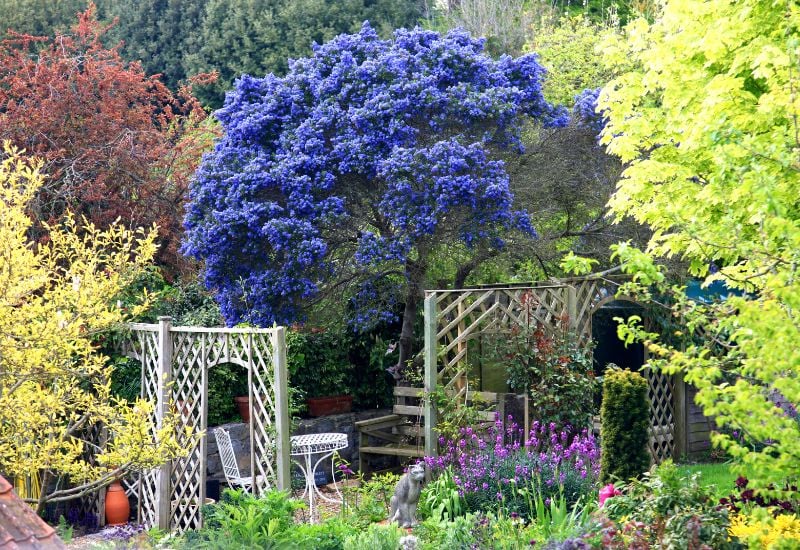
Blue is the relaxing color of clear skies and tropical seas, and trees with blue flowers are always highly sought after in a garden.
Add to this that small touches of blue enhance the green tone of foliage, which nevertheless seemed trivial chlorophyllin, and you will have understood that planting a blue flowering tree is essential.
They can be marries admirably with shrubs with red or purple foliage or with with yellow and orange flowering trees.
But there are very few trees with blooms in this spectrum.
With Jacaranda being the most notable example, if this you want to bring shades of ultramarine, cobalt, cyan, or azure to your garden high up in the fresh canopies, you can train shrubs to become small trees to extend the range of plants also to suit the climate of your region.
However, not all shrubs can be turned into small trees, so we picked a selection of the most beautiful trees with blue flowers, and we will teach you how to make them look just right for your green haven with a touch of sky-colored blooms.
8 Beautiful Trees That Bloom Blue Flowers
This is not a long list, but it is for sure the longer you will find with trees with blue flowers:
And now let’s see how beautiful they are, and how you can train some of them into proper little trees…
1: Green Ebony Tree (Jacaranda mimosifolia)
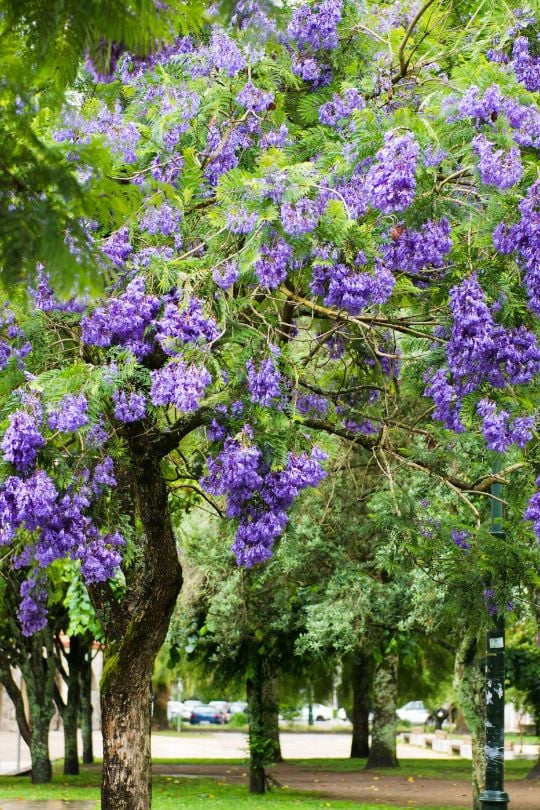
When a gardener thinks, “blue tree”, Jacaranda, or green ebony tree immediately springs to mind. This elegant beauty from South America fills with clusters of funnel shaped blue flowers in late spring and early summer, each reaching 8 inches long (20 cm) and they come in such numbers that the whole crown turns the color of a warm, deep blue sea!
The branches are naturally elegant and with an open habit as well, and when in bloom, the foliage is still small, which means that the flowers take center stage.
When the leaves come, long and segmented into many leaflets (like mimosa, in fact), they will give you a light, finely textured emerald crown that is itself a real asset and a beauty to behold.
Winner of the Award of Garden Merit by the Royal Horticultural Society, green ebony tree is only suitable for warm climates; you will find it on streets and public parks in tropical and Mediterranean cities, in fact.
But if you have the space, and if you live in the right region, like Florida or California, Jacaranda is a real prima-donna in any garden!
2: ‘Blue Satin’ Rose of Sharon (Hibiscus syriacus ‘Blue Satin’)
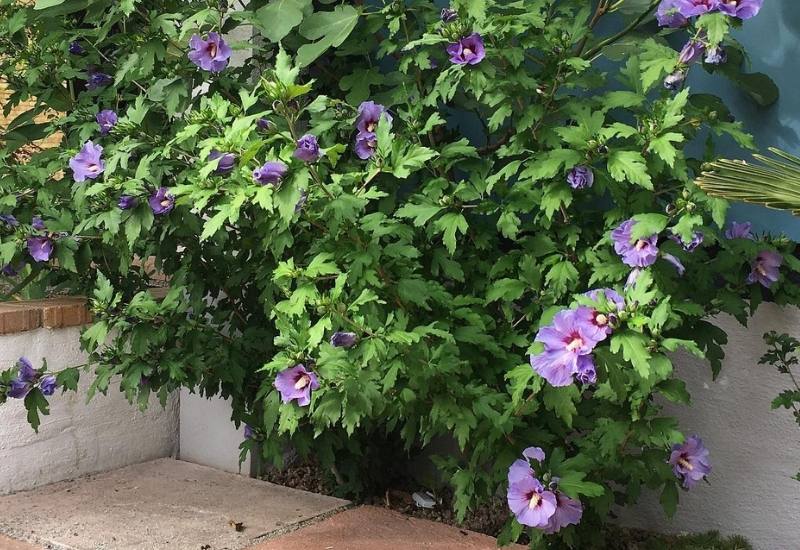
Like all rose of Sharon varieties, ‘Blue Satin’ is a shrub that you can easily train into a tree, and it will give you plenty large, round violet blue flowers with dark purple veins and center for a long time late in the season.
Each blossom is about 4 inches across (10 cm). The tubes of stamens that project from the very middle of the bloom are cream white, adding a touch of light to the ensemble.
The large, deep green lobed leaves are quite dense and healthy, and they accompany the floral display very well indeed. However, this being a cultivar, you will not be able to propagate it by seed.
To make sure your ‘Blue Satin’ rose of Sharon turns into a proper small tree, select one upright and healthy stem and prune off all the others.
Fasten it to a stake till it become 2 inches thick (5.0 cm) and hard, and prune off all lower lateral branches for the first few years. You will get a lovely round crown full of blooms, just like a proper tree.
3: ‘Victoria’ California Lilac (Ceanothus thyrsiflorus ‘Victoria’)
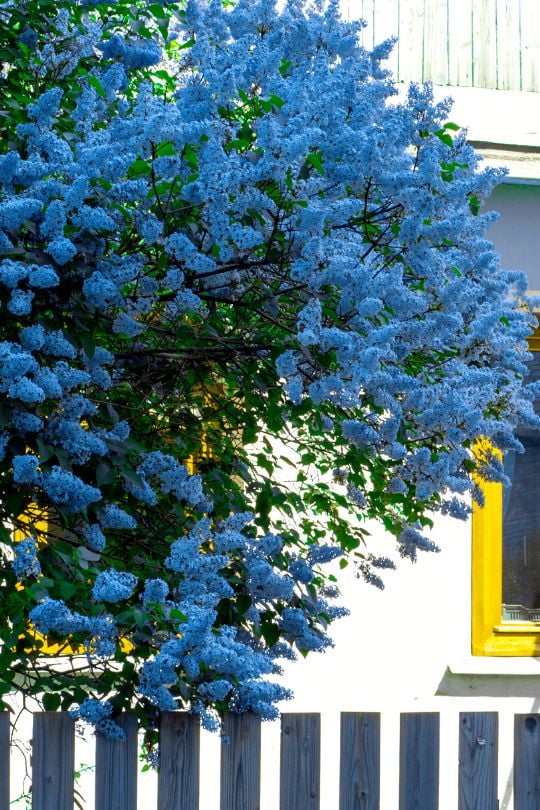
There are many California lilacs with blue flowers, but ‘Victoria’ is unique because it has the purest indigo hue you can find.
The flowers are so profuse and thickly packed that they will literally cover the whole crown for about two months in spring and summer!
This amazing display comes on naturally arching branches which give it a very elegant shape indeed. The leaves are small, deeply veined, shiny and dark green.
Deer will leave it alone if you live in the countryside, but butterflies and humming birds will come to visit your garden even in urban and suburban areas.
This too is naturally a shrub, but you can train it into a small tree by keeping one branch and stake it so that it keeps straight when the plant is young.
Keep the lower part clean from shoots and only allow the upper branches to grow into arching beauties that form an elegant crown. It is very drought tolerant and ideal for coastal gardens.
4: ‘Blue Hong Kong’ Orchid Tree (Bauhinia grandidieri ‘Blue Hong Kong’)
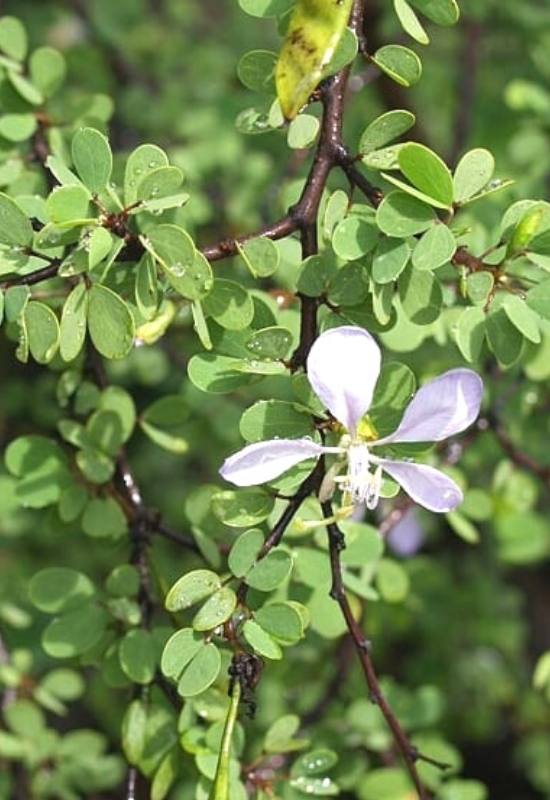
Orchid trees are so called because their blooms are so exotic and showy that they look like, well, orchids, and the rare ‘Blue Hong Kong’ has an unusual color for this species: pale lilac blue.
These may fade as they mature, but their impressive beauty will keep on the branches as real show stoppers.
Reaching about 6 inches across (15 cm), with 5 distinct and arching petals that look like butterfly wings, and a strong and pleasant aroma too!
And it will bloom for months on end… They will turn into pods, because they are relatives of peas, and they are actually edible too.
The crown has a round and open habit, and the green leaves are broad and with two large, exotic looking lobes.
‘Blue Hong Kong’ orchid tree is a natural tree, so you won’t beed to train it. Unfortunately it is not cold hardy, but if you want a show stopping exotic presence in your garden, this rare blue beauty should be on top of your list!
5: Empress Tree (Paulownia tomentosa)
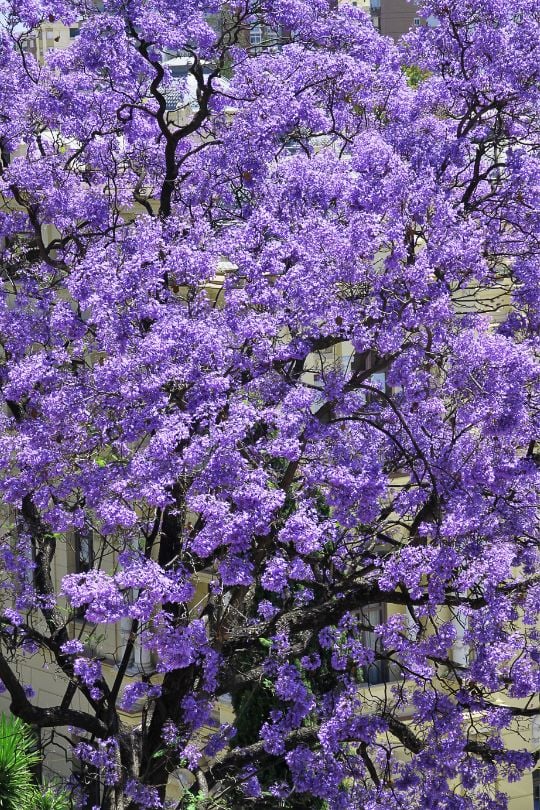
Empress tree, princess tree or simply Paulownia is known as the fastest growing tree on Earth, and it too has flowers that can be lilac blue, though most varieties are lilac pink.
You will need to choose your specimen well if you are after the color of the sky in the blooms. But past this hurdle, you can even grow this giant with showy, funnel shaped flowers from seed!
And in a few years, you will see its crown fill with foxglove like blooms throughout spring time. The broad, dark mid to dark green leaves will follow, and they will hide the green and pointed pods that follow the blooming season.
Empress tree is mainly grown for timber, but this tree is also a real beauty, and in fact it has won the Award of Garden Merit by the Royal Horticultural Society, and it is perfect if you are pressed for time and you need a fast solution for your garden.
6: Ironwood (Memecylon umbellatum)
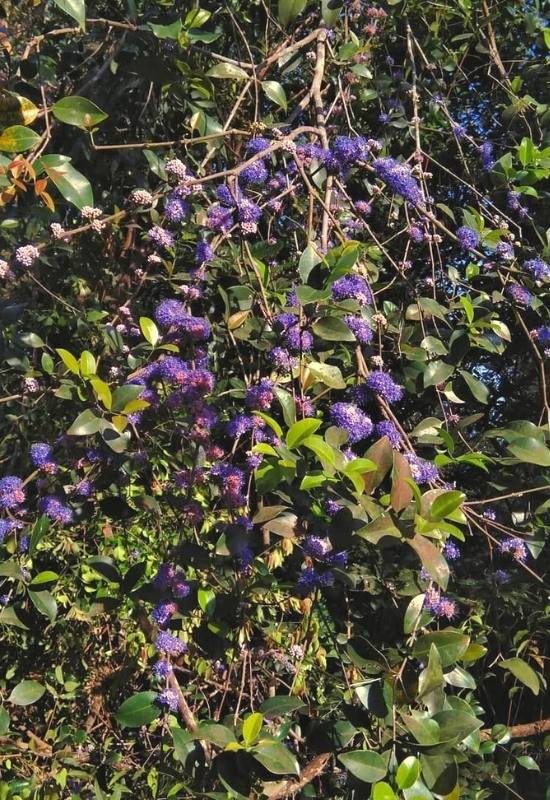
Ironwood is a medium sized tree from Southeast Asia, India and Sri Lanka also called “blue mist” thanks to its fluffy clusters of deep blue flowers.
They come generously among the leathery, glossy and broad deep emerald evergreen leaves. They open straight on the younger branches, and each has 5 short petals and blue stamens that radiate out, like the rays of the Sun, forming a very fine texture.
The contrast between the blooms and foliage could not be stronger. While it is mainly grown for medicinal purposes and to extract a yellow dye from its leaves, it is also a very decorative plant indeed. In fact, it also produced small bluish round fruits!
The main issue you will have with growing ironwood is finding it, because it is not yet common as a gardening tree; however, the good news is that you can even grow it from seed, as well as from layering, and it is growing in popularity thanks to its floral displays.
7: Texas Mountain Laurel (Sophora secundiflora)
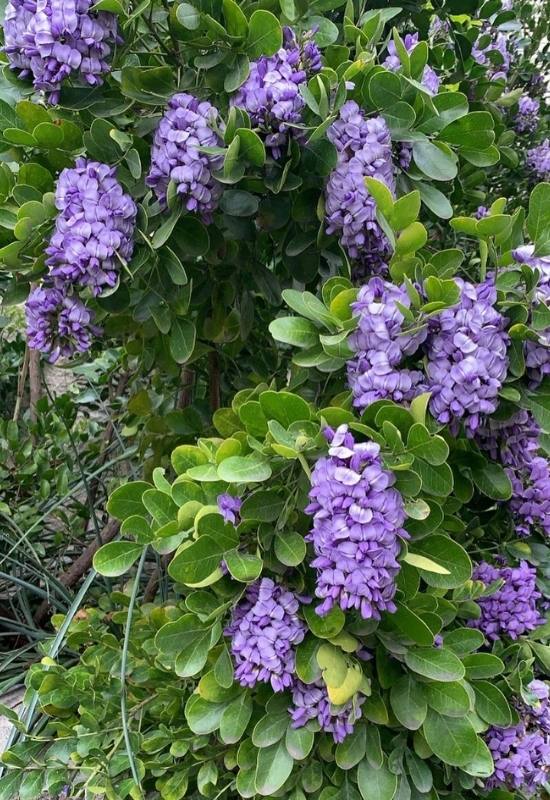
Texas mountain laurel is s slow growing evergreen shrub or small tree with pendulous clusters of purple blue flowers packed together. Each resembles those of wisteria in shape, and they also have a very strong and sweet fragrance, similar to bubblegum.
Packed with pollen, they attract butterflies and pollinators. The foliage is dense, tough, leathery, glossy and olive green, each leaf made up of many leaflets in a pinnate arrangement.
It also produces light pastel brown hard pods that add to the decorative value of this plant, But beware, the blooms and seeds are toxic and narcotic.
Make sure you cut the lower branches when your Texas mountain laurel is young if you want to make it into a tree, and the best shape you can get is that of a multi-trunk, ideal for lush and informal gardens.
8: Blue Chinese Wisteria (Wisteria sinensis)
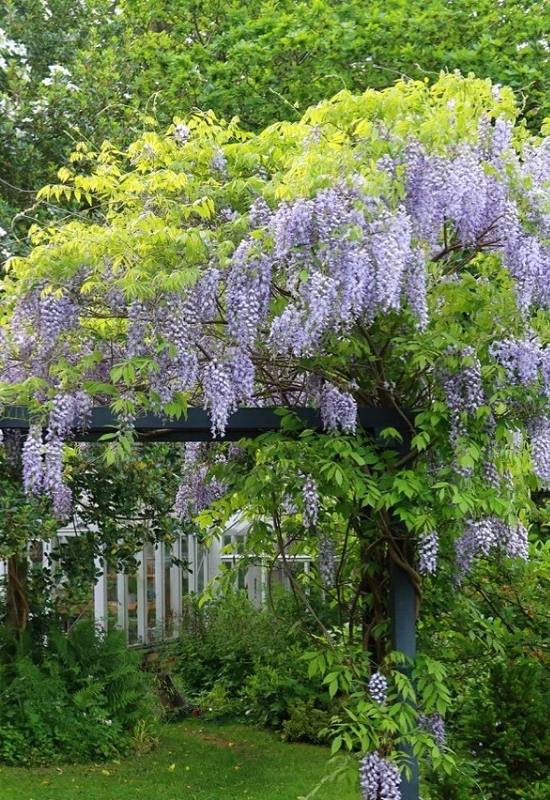
You can even train a beautiful, blue Chinese wisteria into an oriental looking tree with dropping blooms and wonderful arching branches.
Ideal for oriental, Japanese style gardens but also for other informal designs, this climbing shrub thickens and hardens the stems so much that, if you keep it small, it can rest on them like a trunk.
No need to remind you that its blooms are literally mind blowing and its fragrance is intoxicating. Once the blossom is over, you will still enjoy the light green pinnate leaves that form a finely textured canopy that lasts till the end of fall.
Loved by butterflies and pollinators, this oriental beauty is a guarantee of color and elegance in any garden.
To make sure that your blue Chinese wisteria grows into a tree, allow and help two or three stems to twine on each other till they harden into wood.
Use a strong support for the early years; once the plant has matured, you can remove the support and prune the branches to give it an umbrella shape, and just enjoy it year after year.
Lots of Blue Flowers High Up towards the Sky!
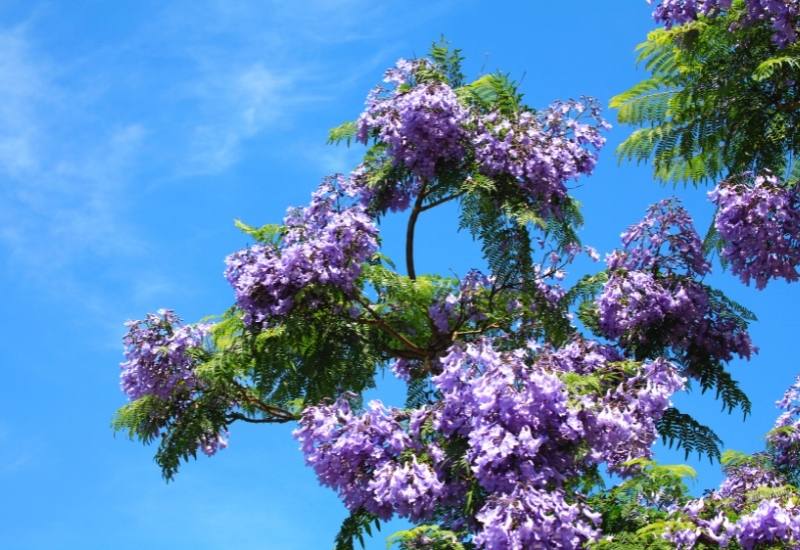
True, they are not many; as we said, only a handful of trees or shrub / trees have flowers in shades of blue.
But the ones we have are very generous bloomers and very decorative indeed. Ranging from a few feet tall to real giants, you too now can have the one for you, to bring the color of the sky into your garden, wherever you are…

Written By
Amber Noyes
Amber Noyes was born and raised in a suburban California town, San Mateo. She holds a master’s degree in horticulture from the University of California as well as a BS in Biology from the University of San Francisco. With experience working on an organic farm, water conservation research, farmers’ markets, and plant nursery, she understands what makes plants thrive and how we can better understand the connection between microclimate and plant health. When she’s not on the land, Amber loves informing people of new ideas/things related to gardening, especially organic gardening, houseplants, and growing plants in a small space.

Victoria’ California Lilac is truly gorgeous! The only 1 that is a true looking blue! I need 1 blue flowered tree or bush that can take full sun in zone 8 & may be able to try this one! ty!